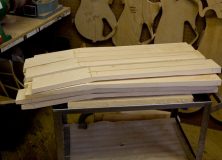
Read Time 5 Minutes
Timing Is Everything
As the old adage goes, “Timing is everything.” When it comes to music, this is especially true. It doesn’t matter how precise and efficient your technique is or if you can play a million notes a minute, if you can’t play in time you just won’t sound good. It is that simple fact that arguably makes a good sense of timing one of the most important qualities any musician could have.
However, there is a great deal of mystery surrounding the idea of timing, or rhythm. Is it an ability we’re born with? Are some people just naturally good at “feeling the beat” or is it something that can be learned? I think the old attitude of “some people just don’t got it!” prevails among many musicians, but it’s my personal and professional opinion that a good sense of timing can be learned, developed and refined.
So how does one do just that? Many guitarists lack an approach to improving their timing, outside of practicing scales along with a metronome. In actuality there are countless things you can do that are much less boring. So for this article I’ve picked out three fun exercises you can try and each of them target weaknesses that I frequently encounter with many of my intermediate guitar students’ rhythm playing. Each exercise described is accompanied with a tab, audio example and an extended backing track for you to practice with.
Exercise 1 – Playing Reggae Rhythm

Playing reggae can be tricky. It’s heavily syncopated and there is a lot of subtle nuance to the way you hold and strum chords. Unless you’ve listened to a lot of reggae, or maybe ska, playing it just won’t come very naturally. So I think it’s a great way to expand your versatility and improve your timing.
The example tabbed above uses a simple reggae chord progression: Am G Dm E7. You’ll probably recognize the chord voicing, which are the typical barre chords, but notice there is more focus placed on the treble strings. This particular example is written in a swing, creating the laid back lazy feel that a lot of reggae music has.
Notice that all the chord strumming happens on off beats. Playing this with a metronome means that these strums would be played in between the clicks. The natural tendency for most people is to slowly gravitate towards strumming on the downbeats as they play through the progression. Try to avoid that pitfall. When you strum the chords you’ll also want to play them very staccato (short). And really, the shorter the better. The proper reggae strum is more percussive than anything else. The staccato sound is achieved by relaxing the pressure applied to the strings by your fretting hand so that the strings go dead. The quicker you un-squeeze the chord after it’s strummed, the more staccato it will be. To get the right tone you’ll also want to strum with a strong flick of the wrist, making the pick hit the strings with a good amount of force.
In addition to the strumming, I’ve added the bass note of each chord on the downbeat of each measure. You can choose to exclude it and focus solely on playing the syncopated strumming, but I think adding the bass notes increases the challenge and is good work for your right hand. Lastly, try to avoid playing extra muted strums – it may help you keep time but can sound sloppy.
Exercise 2 – Funky Rhythm and Bass Riffs

Funkyblues Example2 by guitar-muse
Funkyblues Backing2 by guitar-muse
This exercise is a twelve bar blues In E that mixes some funky rhythm playing with bass line style riffs. Much like reggae, funk is all about timing and articulation. It’s a very syncopated style of music, but in a different way as funk tends to subdivide the beat in sixteenth notes.
Notice almost every measure starts with a dotted-eighth/sixteenth note rhythm. You can count this with the syllables “one-e-and-a,” in which you’ll strum on “one” and “a.” To exaggerate the unevenness of the two chord strums in these instances, you’ll want to hold your first chord for its full value (don’t mute it early) and play the second strum very staccato. The same technique you used to play the reggae chords can be applied here.
In between the sparse chord strumming we have some riffs to fill the space and keep the groove. The riffs themselves are pretty straightforward but If you’ve never played anything like this before you may find the biggest challenge is switching seamlessly between the funky strumming and picked single notes. Doing stuff like this is great for your timing and your chops in general. Plus it can be more interesting than just strumming chords all the way through. Try also playing the single note riffs with a light palm mute for more contrast.
Exercise 3 – Polyrhythms

Polyrhythms Example by guitar-muse
Polyrhythms Backing by guitar-muse
My last exercise is more technical as it deals with how to perform polyrhythms. Most guitarist, unless they are into more technical types of music, don’t give much thought to the concept of polyrhythms. However, practicing polyrhythms is actually great for developing your sense of timing and can be an excellent way of spicing up your rhythm playing in any style of music (when applied tastefully).
A polyrhythm is created anytime there are two different meters being played at one time. This exercise will focus on two common polyrhythms: triplet half notes in a 4/4 meter (3 against 4) and triplet quarter notes in 4/4 (6 against 4 or alternatively you can think of it as 3 against 2).
The trick to performing both of these rhythms is to subdivide the beat in your head in triplets. Triplet half notes are placed on every fourth triplet eighth note, effectively dividing the measure into three even parts. Triplet quarter notes are placed on every other triplet eighth note, thereby dividing the measure into 6 equal parts. In the tab, I’ve included the triplet eight note subdivisions below the guitar part so you can see how the rhythms line up.
This can be easily performed if you set a metronome to click out the triplet eighth note subdivisions, but much harder if your metronome only clicks the quarter notes – harder still if you’re playing with a drummer who’s subdividing in standard eighth notes.
For many of you, just playing either one of these polyrhythms is an exercise in itself. But if you think you’ve got the hang of it, try the exercise I’ve written out, where you’ll practice seamless alternating between playing quarter notes, triplet half notes and triplet quarter notes. In the example I use an open G chord, but what chord you play is really inconsequential. Feel free to play what ever chord you want.
The rhythmic lessons don’t end here. Check out how Steve Vai used rhythmic discipline on “Velorum” off of The Story of Light” in this rhythm ear training lesson, Paul Gilbert’s use of rhythm and melody, or the importance of a good rhythm guitarist.





